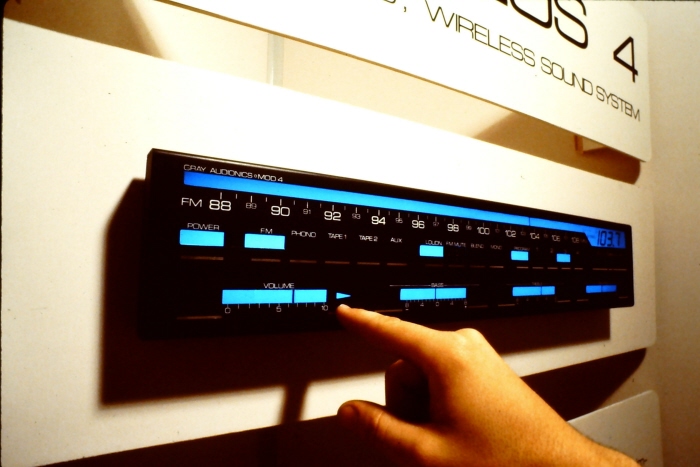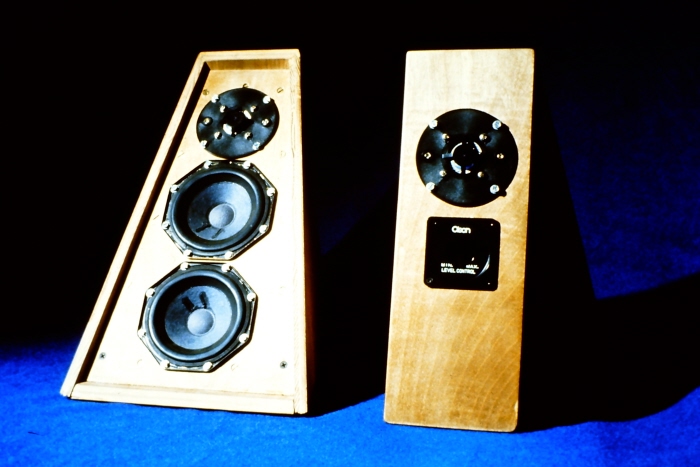
Modulus 4 receiver, Industrial Design Senior Thesis Show - My Senior Thesis Project--Modulus 4 stereo receiver showing electronic capacitive switch operation. Amps were installed inside flat wall-mounted speakers; their audio input signals transmitted by FM modulated infrared beams from the receiver; the entire system was completely wireless, aside from power cords.
The model is made of black anodized, formed aluminum sheet, with screen printed white callouts on its surface. The illuminated areas are faced with flush-mounted Plexiglas sheet.

Modulus 4 receiver in operation - My Senior Thesis Modulus 4 receiver showing its electronic capacitive switch operation. Elimination of all mechanical switching would theoretically improve reliability by 80% over a conventional receiver with mechanical switches.
There are no moving parts in the receiver at all--everything is electronically switched and displayed. Human factors studies I conducted helped determine the optimum design for the control panel.
A tape deck and vertical turntable attached to the ends of the unit.

N4A Stereo Speakers - The project assignment was to build a simple wooden box for a Materials and Processes class. I decided to stretch my woodworking and design skills to build a set of speakers that were based on the principle of ambient sound reflection.
The speaker on the right is actually facing the viewer--most of the sound is reflected from the wall behind the unit. The design proved very successful, but was somewhat difficult to build. The prototypes were constructed of .50" birch veneer plywood.

N4A stereo speakers, rear view - A photo from another angle, showing the angular cabinet design. This is the rear face of the speakers, which would be oriented toward a wall for generation of an ambient sound reflection field. The tweeters on the fronts of the units aided in stereo imaging.
These prototypes still exist, and--they still work. The weird angles of the all the intersecting planes still make my head hurt....

The Happiness Machine, a "mood projector" - This machine was built for an Honors sculpture course during my studies at the University of Cincinnati. The assignment was "create a machine that made the viewer happy".
My machine is designed to be experienced with one's eyes closed. It projects the feeling of being in front of a campfire at night, in a pine forest, with someone softly playing a guitar.
The machine projects pine and smoke aromas, flickering light and IR heat, and a stereo soundfield of a forest (and guitar) at night.

Microscope Slide Projector - Appearance model (non-functioning) of a student-level microscope slide projector.

Handheld electronic stopwatch, closed - This design project dealt with evaluating existing electronic stopwatches on the market, and designing new approaches, based on the shortcomings of the current products.
I decided to design a stopwatch that could be operated by both right and left-handed users, and I tested the designs in a human factors lab, using instrumented stopwatch models.
This working prototype was the result. Not only was it usable by my core user group, the prototype was a fully functional electronic stopwatch.

Handheld electronic stopwatch, open - The resulting prototype was easily operated by left or right-handed users, and folded shut to protect the mode switches and LED display.
The prototype model is fully functional, which was not a requirement of the project. Most of my prototypes were fully functional, which was and is still a personal design philosophy.
I still have this model, and...it still works.

3 channel, 4 digit event counter - Electronic event counter built to work with UC Human Factors Lab modular adaptive logic equipment.

3 channel, 4 digit event counter, internal view - Electronic event counter built from folded Plexiglas sheet, with dead-front red acrylic panel over LED displays.
I still had not discovered styrene sheet at this point in my academic career, so I built everything from folded Plexiglas. That's probably why some of my projects from this period are still around--the stuff is TOUGH!

Locking project light, closed - This project was an assignment to design and built a simple lamp. I decided to create something that I could personally use, so I designed a hanging project light that used two expensive color-balanced fluorescent lamps.
The light they produced was very good for doing accurate color renderings. Then, to protect the lamps when not in use, the case could be closed and locked. Of course, more folded Plex--and it's quarter-inch thick, too.

Locking project light, open - The case had doors that would open into reflectors for the lamps. I included a utility outlet on one end for powering tools and other items.
The entire structure was made from folded plexiglass sheet (this was before I discovered styrene). The upper housing that the lamps and doors mounted to was that quarter-inch thick Plex; bending that was an adventure, but it's tough stuff--I still have the light, and it still works great.
gLike